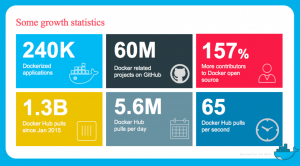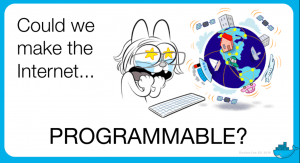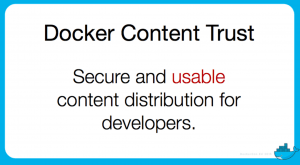Welcome on our new blogpost! This time we have joined DockerCon Europe in Barcellona, in order to learn all the news about one of the most innovative technologies in the actual market, Docker.
There are about 1.500 attendees at the event.
The Day 1 general session has been presented by Ben Golub, Docker CEO.
He started talking about Docker image in the world and he explained that it’s perceived as a developer tool, even if it’s much more than this.
As Solomon Hykes (Docker CTO & founder) said, Docker is about building tools of mass innovation.
There was then a statistic time: he announced that Docker project has more or less 2.000 contributors, and that there are more than 10.000 pull requests.
The global communities around Docker are about 215 throughout 63 countries.
Over 60.000 projects and GitHub have “Docker” in their title.
Then he went through the state of the Project, saying that there are:
- 240.000 dockerized applications
- 1.3 Billion Docker Hub pulls
- 5.6 million Docker Hub pulls per day

Docker has started being a container technology, but now it’s an entire ecosystem of tools.
The initiative of “Open Container” has plus then 35 member companies, 253 github forks and 130 contributors.
Docker has started being used for stateless applications and now it’s growing being used for stateful ones.
According to the largest and most accurate review of Docker adoption, published by DataDog:
- Docker adoption has grown of 5x in last 12 months
- Docker now runs on the 6% of the hosts monitored during this research
- Larger companies (with big number of hosts) are the early adopters of Docker
- 2/3 of companies that try Docker then adopt it
- the average company triples its Docker usage within 5 months
- The Most Widely Used Images Are Registry, NGINX, and Redis
- Docker Hosts Often Run Four Containers at a Time
“Docker in Production” is about making Docker much better and more robust. It has to be portable and good for development as well as operations, secure and Extensible.
Then Solomon went on the stage and started talking about the Internet: there have been lots of upgrades in this field and the biggest obstacle right now is software, that stands between developers and the Internet.

In order to overtake this obstacle, now Docker is building an open Software Layer to make the Internet programmable.
Solomon then talked about the Docker Stack: it compared it to a building with 4 layers.
- Layer 1 are the “Standards”. Everyone must agree on a way to interoperate
- Layer 2 is the Infrastructure: the frame that enables everything to happen. He explained that there has been a lot of work needed to build the plumbing.
- Layer 3 is the Developer Tools. A collection of tools that help developers to have the best experience
- Layer 4 are the Solutions that solve real word problems.
Then he introduced the concept of Docker Quality:
Shipping a feature only with the 1% of the work: then you have to make the feature work every time, for every user, on any device, and what allows this is Quality. Quality is security, reliability, handling failures gracefully.
So how to improve Quality?
- the first focus is the usability of tools: Solomon explains they have been working on usability of tools. Docker compose is the “developer entry point” into the ecosystem. It is the must use tool for developers. The last release, can do “magical” service discovery, can now use a micro-service architecture without rewriting code and build persistent services with volume management.
They have worked on many small usability improvements for developers, like fixing Virtual box integration issues, UI glitches, low priority bugs, better error messages.
Then Anan Prasad ran through a demo of running and developing an app from a fresh computer using Docker Toolbox and Compose. This was to show how easy it is for new developers to get started when you run your development environments with Docker. He created and ran the containers using Docker Compose, installed as part of Docker Toolbox, so they were soon available on Windows.
After this Solomon introduced Docker Security asking how to give developers a “usable security” - developers care about usability, not security. They care about security, as long as it doesn’t affect usability; anyway they will just find a way around it.
They announced Docker and Yubico have joined together in order to create the hardware Crypto support for Docker Content Trust, that gives the ability to survive almost any key compromise - Announcement: - hardware crypto key for Docker Content Trust
There was then a Demo of the product in order to demonstrate that with the right tools, each developer can become an ultra-secure software publisher.
After this Solomon started talking about how Isolation of a container in Linux was difficult: this because so many things “make” a container. Over time this aspect has been improved, in particular with the Swarm/Engine experimental.
Another important question that people are making is “Am I running vulnerable containers?". About this there has been an announcement introducing Project Nautilus, a built-in container security analysis in Docker Hub. It triggers an automated scan anytime a container is pushed to Docker Hub.
Nautilius benefits are:
- Detection vulnerabilities regardless of the Linux Distribution
- discovery of new vulnerabilities in Linux distributions and collaboration with communities to fix them
- developers can use their favourite package manger
With this tool you can be secure without lock in to a specific distro.
The next topic and Demo was “Swarm at scale” by Andrea Luzzardi, Infrastructure Hacker currently building clustering at Docker. Swarm is the easiest way to run Docker app in production. It lets you take an an app that you’ve built in development and deploy it across a cluster of servers. Recently they took Swarm out beta and released version 1.0. An important thing that Swarm needs to be able to do to take your apps to production is: it needs to scale.
He took the demo and he ran 50.000 containers in 1.000 nodes with Docker Swarm in about 5 seconds.
Once they are up and running, Swarm scheduler balances them across the cluster.
Swarm tested 50.000 containers because of the limitation of EC2, but they expect to have better numbers in the future. Docker wants Swarm to become the most scalable and usable system in the industry.
At the end Solomon closed the session saying that Docker is now focusing on quality because they are creating tools of mass innovation. And when you build tools of mass innovation, creative people need reliable tools.
If you want more news from DockerCon EU 2015, follow us on Twitter.
We’ll be back tomorrow for the news about Day 2 Keynote!




